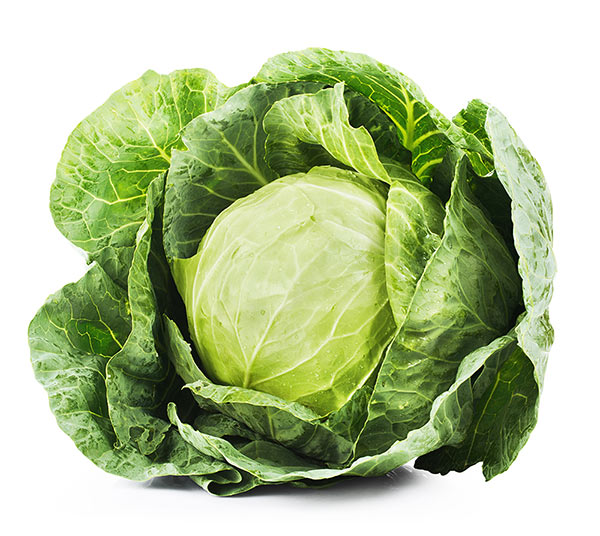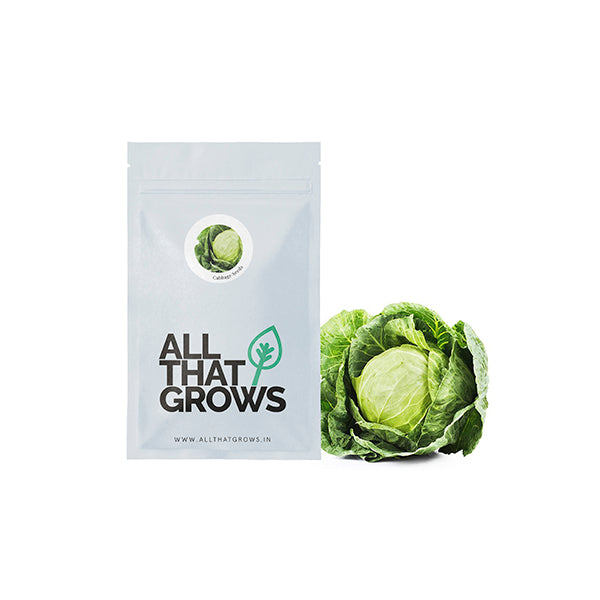



Cabbage Seeds
Seed Type : Non-Hybrid, Open Pollinated and Non-GMO
Maturity: Medium maturity
Head shape : Round, compact, average weight 1.0 to 1.2 kgs, wrapped in 5-6 cup shaped small leaves
Specification : Heads have clear white interior, uniform, suitable for August to October sowing.
Harvesting : after 70-75 days from transplanting
- SOWING
TIMEMay - Dec
- Sowing
DistancePlant to plant - 1'
Line to line - 1.5' - Fruit
Weight1.0 to 1.2 kgs
- Fruit
ShapeRound
- Days to
maturity70-75 days after
transplanting
- Details
- How to sow
- Reviews
The Golden Acre cabbage variety features smaller heads, light green leaves on the outside and dark green leaves on the inside. These can be harvested within 60 - 65 days of planting. This variety is as nutritious and delicious as its regular counterpart and the primary difference lies in the size, shape, and colour of the fruit. It forms a great and healthful staple for the vegetarian diet. Cabbage, as a food source, offers many benefits. It's rich in folate, iron, copper, selenium, vitamin C, sulphur, and anti-oxidants. Many people use cabbage to detoxify their systems and on skin to heal abrasive, acne or oily skin. Cabbage is eaten to treat rheumatism and gout. If you want to add nourishing vegetables to your diet, then the cabbage may be it! Grow your own kitchen garden variety of the Golden Acre cabbage with our pure, open-pollinated seeds! Shop them now.
Planting instructions
Start cabbage seeds indoors 6 to 8 weeks before the final spring freeze.
Harden off plants over the course of a week. To ready the soil, till in aged manure or compost.
Transplant outdoors 2 to 3 weeks before the last anticipated frost date. Choose a cloudy afternoon.
Plant 12 to 24 inches apart in rows, depending on the size of head desired. The closer you plant, the smaller the heads. Mulch thickly to keep moisture and regulate soil temperature.
Practice crop rotation with cabbage every year to avoid a buildup of soil borne diseases. Although cabbage, broccoli, and cauliflower are closely connected, and require similar nutrients, it’s best not to plant them together.
Growing Requirements
watering
Keep soil moist by mulching and water 2 litres per week.
pests
The pests that are vulnerable to this crop are Aphids, Cabbage Root Maggots, Flea Beetles, Cutworms, Splitting.These pests may cause young sprouts to fail to grow or die back; bluish-black spot may appear on leaves and stems. Blackleg is a fungal disease which leaves sprouts girdled and rotting at soil level.
soil
It requires loamy soil with a pH ranging between 6.5 and 6.8
spot
Cabbage needs at least 6 hours of full sun.
temperature
The optimum temperature for growing a successful cabbage crop is 15 - 18 degree celsius (60 to 65 degrees Fahrenheit)
how to harvest
Harvest when cabbage heads reach desired size and are strong.
Cut each cabbage head at its stem with a keen knife. After harvesting, bring inside or set in shade immediately.
To get two crops from early cabbage plants, cut off the cabbage head out of the plant, allowing the outer leaves and root in the garden. The plant will grow new heads—pinch them off until only four or so smaller heads remain. When these grow to tennis-ball size, they'll be perfect for salads.
After harvesting, remove the entire base and root system from the stain to prevent it from disease. Only compost healthy plants put down those with maggot infestation.
Cabbage can be stashed away in the refrigerator for two weeks, wrapped lightly in plastic.

Customer Reviews
The productiveness of any seed we sell is subject to your local climatic conditions*, the sowing method you adopt, and your commitment to the planting process. We give no warranty, expressed or implied, and are in no way responsible for the produce.
Please note that all our seasonal recommendations/ sowing information is as per the local climatic conditions. *For more information on the optimum conditions required for growing seeds in your region, please contact us at, hello@allthatgrows.in or Whatsapp us at, +91 8544865077
Questions & Answers
Ask a Question-
Which variety of cabbage is it?
Hi,
Thanks for writing to us.
The said cabbage seeds are of Golden acre variety.
Best regards,
Team AllThatGrows




Cabbage Seeds
Seed Type : Non-Hybrid, Open Pollinated and Non-GMO
Maturity: Medium maturity
Head shape : Round, compact, average weight 1.0 to 1.2 kgs, wrapped in 5-6 cup shaped small leaves
Specification : Heads have clear white interior, uniform, suitable for August to October sowing.
Harvesting : after 70-75 days from transplanting
The Golden Acre cabbage variety features smaller heads, light green leaves on the outside and dark green leaves on the inside. These can be harvested within 60 - 65 days of planting. This variety is as nutritious and delicious as its regular counterpart and the primary difference lies in the size, shape, and colour of the fruit. It forms a great and healthful staple for the vegetarian diet. Cabbage, as a food source, offers many benefits. It's rich in folate, iron, copper, selenium, vitamin C, sulphur, and anti-oxidants. Many people use cabbage to detoxify their systems and on skin to heal abrasive, acne or oily skin. Cabbage is eaten to treat rheumatism and gout. If you want to add nourishing vegetables to your diet, then the cabbage may be it! Grow your own kitchen garden variety of the Golden Acre cabbage with our pure, open-pollinated seeds! Shop them now.
Seed Type : Non-Hybrid, Open Pollinated and Non-GMO
Maturity: Medium maturity
Head shape : Round, compact, average weight 1.0 to 1.2 kgs, wrapped in 5-6 cup shaped small leaves
Specification : Heads have clear white interior, uniform, suitable for August to October sowing.
Harvesting : after 70-75 days from transplanting
- SOWING
TIMEMay - Dec
- Sowing
DistancePlant to plant - 1'
Line to line - 1.5' - Fruit
Weight1.0 to 1.2 kgs
- Fruit
ShapeRound
- Days to
maturity70-75 days after
transplanting
Planting instructions
Start cabbage seeds indoors 6 to 8 weeks before the final spring freeze.
Harden off plants over the course of a week. To ready the soil, till in aged manure or compost.
Transplant outdoors 2 to 3 weeks before the last anticipated frost date. Choose a cloudy afternoon.
Plant 12 to 24 inches apart in rows, depending on the size of head desired. The closer you plant, the smaller the heads. Mulch thickly to keep moisture and regulate soil temperature.
Practice crop rotation with cabbage every year to avoid a buildup of soil borne diseases. Although cabbage, broccoli, and cauliflower are closely connected, and require similar nutrients, it’s best not to plant them together.
Growing Requirements
watering
Keep soil moist by mulching and water 2 litres per week.
pests
The pests that are vulnerable to this crop are Aphids, Cabbage Root Maggots, Flea Beetles, Cutworms, Splitting.These pests may cause young sprouts to fail to grow or die back; bluish-black spot may appear on leaves and stems. Blackleg is a fungal disease which leaves sprouts girdled and rotting at soil level.
soil
It requires loamy soil with a pH ranging between 6.5 and 6.8
spot
Cabbage needs at least 6 hours of full sun.
temperature
The optimum temperature for growing a successful cabbage crop is 15 - 18 degree celsius (60 to 65 degrees Fahrenheit)
how to harvest
Harvest when cabbage heads reach desired size and are strong.
Cut each cabbage head at its stem with a keen knife. After harvesting, bring inside or set in shade immediately.
To get two crops from early cabbage plants, cut off the cabbage head out of the plant, allowing the outer leaves and root in the garden. The plant will grow new heads—pinch them off until only four or so smaller heads remain. When these grow to tennis-ball size, they'll be perfect for salads.
After harvesting, remove the entire base and root system from the stain to prevent it from disease. Only compost healthy plants put down those with maggot infestation.
Cabbage can be stashed away in the refrigerator for two weeks, wrapped lightly in plastic.



 Sign In
Sign In








